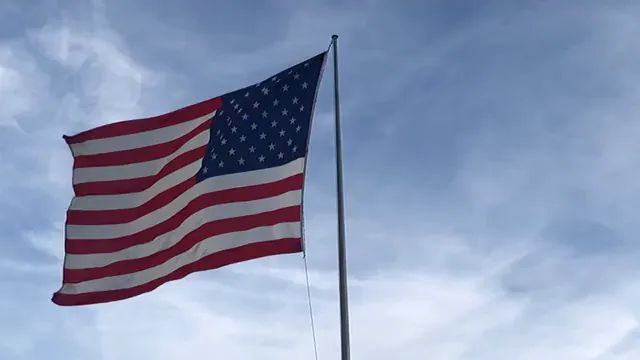
Why Is the Flag at Half-Mast?
Introduction
Have you ever looked up at a flag flying half-mast and wondered, “What’s going on? Did the flag lose a bet?” Well, fret not! The practice of flying flags at half-mast is a significant symbol of mourning and respect worldwide. It’s a solemn reminder that even our national banners have emotions – they, too, grieve.
Historically, this custom dates back to the 17th century, originating from naval traditions. When a ship’s crew lost a member, the flag was lowered to signify their sorrow. Today, this poignant gesture continues to resonate, representing mourning for individuals, events, and tragedies that touch our hearts.
In today’s world, flags are frequently flown at half-mast. You might notice them lowered during national tragedies, memorial services, or in honor of notable individuals who have passed away. From the United States to Australia, this practice transcends cultures and nations, each with its own unique customs surrounding it. Isn’t it curious how a simple flag can unite so many different societies in respect and remembrance?
If you’re interested in diving deeper into the significance of flags, you might want to check out The Meaning of Flags: A Comprehensive Guide. It’s packed with insights and trivia that will make you the flag expert among your friends!
As we look into the reasons behind these displays, we uncover a tapestry of emotions and traditions. So, whether you’re a flag aficionado or just someone who occasionally glances up at the sky, let’s unravel the significance of this enduring practice.

Summary of Key Points
Let’s break down what it means when we see a flag at half-mast. First things first, what’s the difference between half-mast and half-staff? Half-mast refers to flags flown on ships, while half-staff is the term used on land. It’s a small distinction, but one that helps clarify our conversation.
Flags are commonly lowered on specific occasions. These include national tragedies, memorial days, and the deaths of significant figures, such as government officials, military members, or first responders. For instance, in the United States, flags fly at half-staff on days like Memorial Day and Patriot Day, commemorating the lives lost in tragic events.
Recently, various states have observed half-mast displays. For example, Massachusetts and Illinois have ordered flags lowered to honor local heroes and significant events. These actions reflect a communal response to loss, reminding us that we are all part of something greater.
Speaking of flags, if you’re planning to display your own, consider investing in a high-quality Outdoor American Flag Set. It’s perfect for showing your patriotism while ensuring your flag looks great all year round!
Cultural variations play a fascinating role in this practice. In Canada, flags are lowered during specific days of national remembrance, like Remembrance Day. Meanwhile, in Australia, flags are flown at half-mast for notable citizens, such as Steve Irwin. Each country has its own set of protocols and occasions that dictate when flags should be lowered, creating a rich tapestry of customs.
In the United States, federal and state protocols guide these displays. The President or state governors can order flags to half-mast, ensuring that the nation collectively grieves. Local governments often follow suit, honoring local figures and events that impact their communities.
To sum it up, the practice of flying flags at half-mast serves as a universal expression of grief and respect. It bridges cultures and nations, reminding us that loss is a shared human experience. Next time you see a flag at half-mast, you’ll know it carries a deeper meaning than just a low hang. It’s a symbol of solidarity, mourning, and remembrance.

The Meaning Behind Half-Mast
Historical Context
The tradition of flying flags at half-mast has deep roots, especially in naval customs. It traces back to the 17th century, where sailors used this solemn act to express mourning. When a ship’s crew lost a member, they lowered their flag to signify their grief. This gesture soon evolved into a universal symbol of sorrow.
Lowering a flag is more than just a visual cue; it’s layered with meaning. The act represents a mark of respect, a silent salute to those who have departed. Some lore even suggests that the flag is lowered to make room for an invisible flag of death flying above. While this may sound like a ghost story, it reflects the profound respect held for the deceased.
Historical anecdotes abound, showcasing this tradition. For instance, during World War II, flags were flown at half-mast across many nations to honor fallen soldiers. After the assassination of U.S. President John F. Kennedy in 1963, flags were lowered nationwide. Such moments bind nations together in shared grief.
For those fascinated by this history, consider picking up a copy of Historical Flags of the United States Book. It’s a treasure trove of information that will deepen your appreciation for these symbols of history.

Cultural Significance
The half-mast tradition is not just an American practice. Different cultures interpret and honor this tradition in unique ways. For example, in Australia, flags are flown at half-mast upon the death of a government official or during national tragedies. In contrast, Canada commemorates significant anniversaries and notable deaths, such as Remembrance Day or the passing of influential figures.
In the UK, the Union Flag is lowered to half-mast to mark the passing of royal family members. This was notably seen during the mourning period for Queen Elizabeth II. Interestingly, in India, flags are lowered upon the death of high-ranking officials, showcasing a formal respect that’s culturally significant.
Moreover, during tragedies like the 2011 Norway attacks, many countries displayed flags at half-mast in solidarity. This act transcends borders and politics, uniting people in a collective expression of mourning. Each time a flag is lowered, it serves as a poignant reminder of our shared humanity.
If you enjoy learning about flags from around the globe, you might appreciate the Flags of the World Poster. It’s not just educational; it’s also a fantastic decoration for your space!
While the protocols may differ, the underlying sentiment remains the same: a flag at half-mast is a universal symbol of respect, mourning, and remembrance. It’s a reminder that, regardless of where we come from, we all experience loss. The next time you see a flag in this position, remember the stories and emotions it represents, connecting us all in a shared experience of grief and respect.

U.S. Regulations
In the United States, the flag flies at half-mast as a solemn gesture of mourning. The authority to order this display lies primarily with the President, state governors, and in some cases, local officials. This means your local mayor might have the power to make the flag droop too!
Flags are typically lowered in response to significant events. These may include the death of a government official, military member, or first responder. National tragedies, such as 9/11, also trigger this protocol, allowing the nation to collectively express grief.
The duration for half-mast displays varies. When a U.S. President passes, flags are lowered for 30 days. For the Vice President, Chief Justice, or Speaker of the House, it’s 10 days. For lesser-known officials, the flag might drop until interment. Memorial Day also sees flags at half-staff until noon, honoring those who sacrificed their lives.
For those interested in a deeper understanding of the rules governing flag displays, the U.S. Flag Code Book is an essential read. It’s the perfect companion for anyone keen on mastering flag etiquette!

State-Specific Protocols
States have their own unique protocols regarding half-mast flag displays. For instance, in Illinois, flags are lowered for every member of the armed forces, police, or fire service killed in the line of duty. The flags fly at half-staff from sunrise on the day of the funeral and for the two days leading up to it.
Recent proclamations from various states reflect the diverse reasons for lowering flags. In Massachusetts, Governor Maura Healey ordered flags to half-staff to honor a significant local event. Similarly, in Connecticut, Governor Ned Lamont directed flags to fly low for a beloved volunteer firefighter who passed away.
Local governments and communities also play a vital role. They often decide to observe half-mast displays for local figures or tragedies. This community involvement transforms a national gesture into a local expression of grief, fostering a sense of belonging and shared mourning.
For those who want to commemorate their local heroes, a Customizable Flag Display Case could be a great way to honor their memory. It’s perfect for preserving flags and showcasing your pride!
Flags fluttering at half-mast, whether on a grand scale or within a tight-knit community, remind us of the collective respect we hold for those we’ve lost.

Recent Events Leading to Half-Mast Displays
Flags flying at half-mast evoke a poignant sense of loss. Recent events have prompted this display, uniting communities in mourning. One of the most significant occasions is the anniversary of the September 11 attacks. Each year, on Patriot Day, the United States remembers the nearly 3,000 lives lost in 2001. Flags across the nation are lowered, creating a reflective atmosphere where individuals honor the victims and heroes alike.
Local tragedies also instigate half-mast displays. For instance, in 2024, Connecticut Governor Ned Lamont ordered flags to half-staff to honor Robert Sharkevich Sr., a beloved volunteer firefighter. Such decisions resonate deeply within communities, allowing people to come together in remembrance of their local heroes.
Other states have shown similar responses. In Massachusetts, Governor Maura Healey ordered flags lowered on various occasions, reflecting the emotional weight of loss felt statewide. Illinois Governor JB Pritzker has mandated flags at half-mast for recent events, reinforcing the collective grief shared by citizens.
The impact of these displays transcends the act of lowering a flag. It serves as a visual reminder of our shared humanity and the deep connections we have with one another. Each time a flag droops, it whispers stories of those lost, inviting reflection and conversation. Whether it’s a national tragedy or a local hero’s passing, half-mast displays resonate with profound significance, showcasing unity in the face of sorrow.
In 2024, flags were also lowered across Georgia to honor Sheriff Henry Cullen Talton, Jr., marking another moment of respect for those who serve and protect. Similarly, in New Mexico, flags were ordered to half-staff in memory of former state senator John Arthur Smith, demonstrating how local leaders recognize the importance of grieving together.
These moments remind us that loss is not just a personal experience; it’s a communal one. Each half-mast display becomes a shared act of remembrance, reinforcing the emotional bonds that unite us as a society. As we reflect on these events, we appreciate the rich tapestry of human connection woven through shared grief. In every drooping flag, there lies a story, a memory, and a testament to those we honor.

FAQs about Half-Mast Flags
Why is it called ‘half-mast’ vs. ‘half-staff’?
The terms differ in usage. ‘Half-mast’ refers to flags flown on ships, while ‘half-staff’ applies to flags on land. It’s a small nuance with big implications!
Are private organizations required to lower flags?
No, private organizations are not legally required to lower flags. However, many choose to do so as a sign of respect and solidarity.
How can individuals stay informed about half-mast notifications?
Staying updated is easy! Many states provide alerts via email. You can subscribe to notifications from local government websites or follow flag etiquette organizations.
When should flags be flown at half-mast?
Flags are typically lowered for the death of significant officials, military members, or during national tragedies. Events like Memorial Day also see flags at half-staff until noon to honor those who sacrificed their lives.
What’s the duration for half-mast displays?
The duration varies. For a U.S. President, flags are flown at half-staff for 30 days. For others, it may range from the day of death until interment or for specific national observances.
Do all states follow the same protocol?
While the general practice is similar, each state has unique rules regarding when and how to display flags at half-mast. It’s essential to check local regulations for any specific occasions.
Can we expect future half-mast displays?
Absolutely! As we continue to experience loss in various forms, flags will keep flying at half-mast as a universal symbol of respect and mourning. These displays will continue to foster unity during difficult times.

Conclusion
Flying flags at half-mast is more than just a tradition; it’s a heartfelt expression of collective grief and respect. This symbolic act has deep cultural and historical roots, reminding us of our shared humanity and the losses we endure together. Whether it’s in memory of a fallen hero, a national tragedy, or a day of remembrance, half-mast serves as a visual testament to our ability to unite in sorrow.
From the naval customs of the 17th century to modern-day practices, the meaning behind half-mast has evolved but remains steadfast. This gesture transcends borders, cultures, and generations, conveying a universal message: we honor those who have passed and acknowledge the impact they have had on our lives.
In our communities, the sight of a flag at half-mast can stir a myriad of emotions. It invites reflection and conversation, often prompting us to remember the stories behind the loss. Have you ever looked at a half-mast flag and felt a pang of sadness or nostalgia? Perhaps it reminded you of a cherished memory or a local hero. These flags serve as reminders that we are all part of a larger tapestry of human experience, one that weaves together joy and sorrow.
As you encounter half-mast displays in your community, take a moment to appreciate their significance. Engage with your neighbors, share stories, and foster a sense of solidarity. After all, these flags are not merely fabric; they represent the heartbeats of those we’ve lost and the love we continue to carry for them.
So, the next time you spot a flag at half-mast, remember its weight of emotion and history. Let it inspire you to share your experiences with others. Together, we can celebrate the lives touched by loss and honor their memory in our hearts.

Additional Resources
For those intrigued by the protocols of flag displays and the rich history of half-mast practices, several resources can provide deeper insights.
1. Official Government Websites: Many countries have dedicated pages outlining their flag protocols. For instance, you can visit the U.S. Flag Code for details on when and why flags are flown at half-staff. Similarly, the Government of Canada provides comprehensive guidelines for half-masting notifications.
2. Flag Organizations: Organizations like the American Flags Express regularly publish half-staff proclamations and notifications, allowing citizens to stay informed about flag displays in their areas. You can also explore their American Flags Express Proclamations Book for more details on flag etiquette.
3. Books and Articles: For a more in-depth exploration, consider reading texts on flag history and customs. These publications often contain anecdotes, historical contexts, and cultural variations that enrich our understanding of this powerful symbol. A good start would be Flag Etiquette Guidebook, which offers great insights into the dos and don’ts of flag handling!
4. Online Communities: Engaging in online forums or local groups can also provide valuable perspectives. Sharing experiences about half-mast displays can enhance your appreciation of this solemn tradition.
By utilizing these resources, readers can not only enhance their knowledge but also foster a greater appreciation for the meaning behind half-mast flag displays in their communities.
To understand more about the significance of flags being at half-staff, you can read about why is the flag at half-staff today 2023.
Please let us know what you think about our content by leaving a comment down below!
Thank you for reading till here 🙂
All images from Pexels




